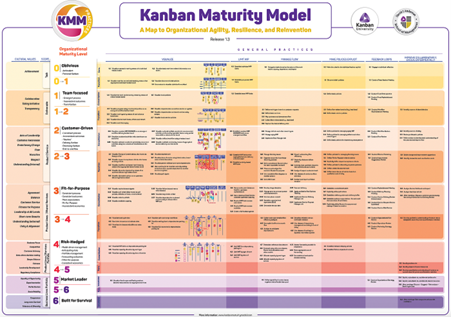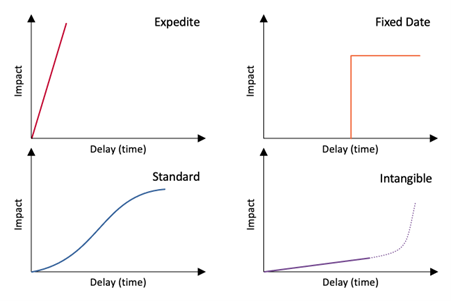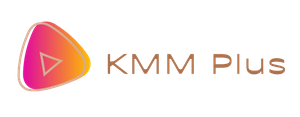We would like to share an interesting article from Vikas Agarwal an Agile Coach and Accredited Kanban Trainer (AKT).
In this article Vikas Agarwal explains in detail common mistakes in designing a Kanban board and how to avoid them. We appreciate the community of our Kanban Maturity Model Contributors for the interesting and useful content.
If you have implemented Kanban but do not know if it has improved business agility and predictability, read this article.
You could have created a “status” board, not a “Kanban” Board. The reason for this is that implementing the correct Kanban board can be complicated due to our reliance on project management tools. In a way, these tools act as a blindfold. Sometimes, organizations become too heavily dependent on the tools to handle the anti-patterns of their agile teams. Those using lightweight and heavyweight frameworks, in particular, feel the most pain when shifting to Kanban. To put it another way, they get use to developing agile improvements around the functionality of the tools.
Making the Tools Happy
Two metrics have become prevalent in their journey to bring Agile improvements: Burn Down Graphs and Velocity Charts. These two metrics have become the bread and butter for Scrum Masters and Agile Coaches. Most of the agile improvements focus on sugarcoating the above two metrics. For example — one of the most common pitfalls of sprint-based agile approaches is the “handling of spill-over.” We try to handle spill-over by maneuvering our practices:
1. Lessening the story points/effort.
2. Splitting the story into two.
3. Reducing the story’s scope (without reducing size) and pushing it to Completed status.
The above practices help us create good burn-down graphs and achieve better velocity. The improved metrics falsely show that the teams have improved their agility. This myopic vision of improving the practices around the tools steals the power to think “out of the box.”
Kanban, Oh, Is It? No, It’s Different
And this is one of the reasons why some of the Kanban implementations do not produce any results. The organizations start by creating a JIRA Kanban Board. To do so, they follow the guidance in the files provided by the Developers of tool. The following is a sample introduction mentioned in the help files/articles of the Kanban Board in JIRA:-https://www.atlassian.com/software/jira/features/kanban-boards.
“Kanban boards give your team full visibility into what’s next, so when one work item is completed, the team can quickly move on to the next. Jira Software Kanban boards are ideal for teams who practice agile methodologies; teams of all types can take advantage of the kanban board to facilitate smooth project management.”
These are the pearls of wisdom for someone unfamiliar with Kanban but not for a well-educated Kanban professional. For them, it is like “shooting yourself in the foot.”
Let us understand the above paragraph more deeply. In this article, I will also clarify some of the myths of Kanban. Let us discuss three phrases used in the above paragraph:
1. Full Visibility,
2. Quickly move on to the next, and
3. Facilitate Smooth Project Management

Full Visibility
What does “full” mean here? Is it — “packed,” “filled,” “crowded?” How do you determine “full” in terms of “visibility.” People tend to create their own definition of “full,” and each definition varies. Most of the time, we need help figuring out what it makes sense for us to visualize. Using the JIRA Kanban Board, we create an SDLC (Software Development Life Cycle). The Kanban Board created with the SDLC thought process only acts as a status tracking board. It worsens when we question people’s ability to finish the work. By setting the WIP (Work in Progress) Limits but not following them we make it worse.
Kanban is not a board to track the status.
Kanban is a method for knowledge work management. It has six general practices. Visualization is one general practice of Kanban. It means visualizing the work, workflow, and business risks using visual boards, which can be physical or digital.
For example, for a maturity level 3 (Fit-For-Purpose) organization, the teams should visualize the following:
1. Visualize Ready to Commit status, also known as Ready to Pull.
2. Visualize request acceptance criteria, also known as entry criteria.
3. Visualize workflow and teams’ work items using an aggregated teams kanban board.
4. Visualize ideas development using an upstream (discovery) Kanban board.
5. Visualize discarded options on an upstream (discovery) kanban board.
6. Visualize aborted work.
7. Visualize the class of service using ticket colors, board rows, or ticket decorators.
8. Visualize parent-child and peer-peer dependencies.
9. Use a parking lot to visualize currently waiting or blocked work requests dependent on another service or system.
10. Visualize pull signals.
11. Visualize replenishment signals.
12. Visualize pull criteria (also known as pull policies, the definition of done, or exit criteria).
13. Visualize what is pullable.
14. Visualize available capacity.
15. Visualize failure demand versus value demand.
16. Visualize the target date or SLA.
17. Visualize dependencies on shared services using a column with a WIP limit.
Kanban University also provides a General Practice Map of the Kanban Maturity Model. This map acts as a guide to achieve the organization’s proper visibility. Kanban Maturity Model is “a map to Organizational Agility, Resilience, and Reinvention.”

Download the Kanban Maturity Model - General Practice Map in printable pdf for free from kmm.plus.
“The Kanban Maturity Model codifies more than 10 years of experience implementing Kanban across diverse industries, in businesses small to extremely large. It plays an important role in creating unity, alignment, a sense of purpose, and good governance. Use it to gain a better sense of achievement, provide better products and services, delight your customers, and realize superior business results.”
https://www.kanbanmaturitymodel.com/
KMM describes seven maturity levels of an organization:
1. Oblivious,
2. Team-focused,
3. Customer-Driven,
4. Fit-for-Purpose,
5. Risk-Hedged,
6. Market Leader, and
7. Build for Survival.
And you thought that it was just about “full” visibility.
Quickly move on to the next: Classes of Service
Now let us discuss the next phrase used in the JIRA Kanban Board Help File/article — “quickly move to the next.” How quick?
Agile is not about delivering faster but delivering the right value at the right time.
Kanban Boards help to visualize the Explicit Policies so that you can make the right pull decision. “Classes of Service” is one of the examples of explicit policy. It is one of the most powerful concepts that help you make the right pull decision. The Kanban method discusses the four classes of services:
1. Expedite,
2. Standard,
3. Fixed Date, and
4. Intangible.
These classes of service are based on the concept of cost of delay.
Cost of Delay is “a way of communicating the impact of time on the outcomes we hope to achieve.” Cost of Delay combines an understanding of value with how that value leaks away over time. It is a tactic that helps communicate and prioritize development decisions by calculating the impact of time on value creation & capture.
https://en.wikipedia.org/wiki/Cost_of_delay
The four classes of service represent the following four archetypes.

Expedite means that the cost of delay is high and immediate. If you have an expedite, the team should treat it as the highest priority. The team should leave everything and start working on the expedited scope item.
Standard means the cost of delay increases with time. The team should strive to deliver standard scope items before their value diminishes.
Fixed Date means that the cost of delay is after a specified date. There will be no impact until the due date, but if not delivered, the impact will be higher and will remain forever. Mostly, regulatory scope items fall into this class of service.
Intangible means there may or may not be an impact, but if the impact happens, it will be high. Mostly, technical debt tickets fall under this category.
The “classes of service” help you to set the priority so that you do not have to move quickly to finish everything.
Quickly move on to the next: Lead Time Distribution (Bonus)
And when you implement Kanban, you can determine the “Service Level Expectations.” You can calculate the Lead Time. Kanban enables you to create a Lead Time Distribution for your work delivery. This metric helps you determine the predictability of your deliverables. Believe it or not, the Lead Time Distribution will make you predictable. You could say, “We can deliver the scope in 12 days or less, and we are 80% confident.” And this is the predictability that the organizations strive to achieve.
Lead time is:
1. The indicator of value.
2. It helps to establish realistic SLAs/SLEs (Service Level Agreements/Service Level Expectations).
3. It enables predictability.
4. It will help you to reduce waiting, accelerate delivery and stay lean.
5. It helps to assess the overall performance of the team.
The idea is not to move quickly but to deliver value to your stakeholders at the right time with the right predictability.
Facilitate Smooth Project Management
JIRA Kanban Board help files mention this term — ‘facilitate smooth project management”. This often creates a myth that “Kanban is a Project Management Method.” Kanban is an Evolutionary Change Method.

The Kanban method provides us with three sets of principles:
1. Change management principles
2. Service delivery principles
3. Scaling principles
The Change Management Principles of Kanban focus on:
“Start with what you know.”
It talks about visualizing the existing processes and policies without bringing any change.
It tells us to respect the existing roles and responsibilities.
The Change Management Principles of Kanban avoid resistance. This lack of resistance helps the organizations to introduce an Evolutionary Change.
Kanban method believes in the philosophy of “be like water.” And this is one of the most famous quotes from Bruce Lee — “Be Water, My Friend.” In one of the interviews with Pierre Berton in 1971, Bruce Lee mentioned — “Empty your mind, be formless, shapeless, like water. Now you put water into a cup, it becomes the cup. You put water into a bottle, it becomes the bottle. You put it in a teapot, it becomes the teapot. Now water can flow, or it can crash! Be water, my friend.”
With this concept, the Kanban method guides us to work around the resistance. If rock represents the resistance, the water flows around it.
The Kanban Method provides us with the approaches:
1. To identify and remove the sources of delay,
2. Visualizing dependencies and bottlenecks, and
3. Identify variations,
4. It focuses on bringing smaller changes that lead to an evolutionary change.
If not JIRA Kanban Board, how should you design the Kanban Board?
Use STATIK — Systems Thinking Approach to Introducing Kanban. STATIK is based on Systems Thinking Approach. It helps you understand how the different components of the system interact with each other. It allows you to create simpler and more meaningful Kanban Board Designs. It consists of the following steps:
1. Understand what makes the business fit for purpose.
2. Understand sources of dissatisfaction.
3. Analyze the source and nature of demand.
4. Analyze current delivery capability.
5. Model the service delivery workflow.
6. Identify and define classes of service.
7. Design the Kanban System.
8. Socialize design and negotiate implementation.
A Kanban Board design consists of the following elements of Kanban:
1. Work Item Types.
2. Workflow States.
3. Sources of Variability.
4. Queue Replenishment Policy.
5. Classes of Service.
6. Replenishment and Release Frequencies.
7. Visualization — Board Design and Ticket Design.
8. Metrics and Reporting.
9. Commitment Points.
10. Related/Explicit Policies.
How to become Kanban educated?
Here are the two most popular reads to learn Kanban:
- Kanban: Successful Evolutionary Change for your Technology Business by David J. Anderson
- Kanban from the Inside by Mike Burrows.
You can find these books on kanbanbooks.com
Another way to learn Kanban is to attend the 4-day Kanban Management Professional (KMP) Workshop. The KMP Workshop consists of two modules:
1. Kanban System Design — In this workshop, you will learn to design the Kanban System.
2. KSI (Kanban Systems Improvement) — In this workshop, you will learn to scale and improve Kanban.
The Kanban Management Professional course at Kanban University explains the above concepts using two case studies.
1. Microsoft XIT Case Study and
Read this case studies on kmm.plus.
For more details on KMP, refer to this series of 8 articles:
5. Part 5 (Design a Kanban Board)
7. Part 7 (Scaling Kanban, Upstream Kanban, and Feedback Loops)
8. Part 8 (Strategies for Improvement, Up your GAME)
To register for KMP courses you can go to the Kanban University Website.
Conclusions
“Half-knowledge is worse than ignorance” — Thomas B. Macaulay.
I want to be straightforward here. Refrain from depending on the tools. Stop expecting the tools to implement Kanban to improve your system by themselves. Learn Kanban to implement Kanban — it’s not just a “board.”
Author: Vikas Agarwal, Agile Coach and Accredited Kanban Trainer (AKT)


